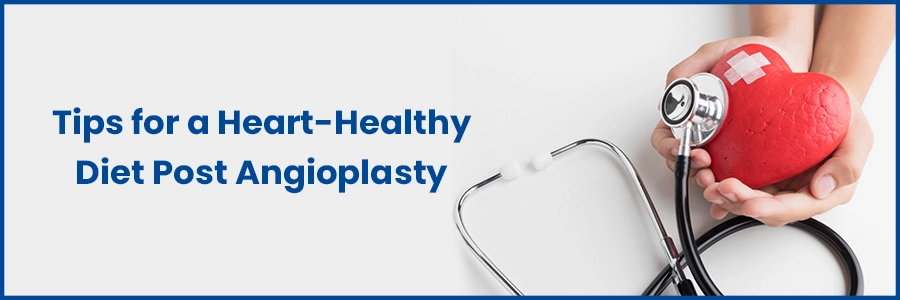- Cardiology 84
- Dermatology 45
- Endocrinology 33
- ENT 16
- Fertility 190
- Gastroenterology 78
- General-Medicine 81
- Gynecology 80
- Hematology 19
- Infectious-Diseases 33
- Neurology 52
- Oncology 34
- Ophthalmology 23
- Orthopedics 69
- Pediatrics 31
- Procedure 23
- Public-Health 144
- Pulmonology 59
- Radiology 8
- Urology 68
- Wellness 161
- Woman-and-child 77

Diet After Angioplasty
Angioplasty is a common medical procedure used to open blocked or narrowed arteries, improving blood flow to the heart. After the procedure, it's essential to follow a specific diet to aid in the recovery process and prevent future complications. Here's a comprehensive guide to help you navigate the dietary changes you may need to make.
Understanding the Post-Angioplasty Diet
After an angioplasty, your body needs time to heal and recover. The post-angioplasty diet is designed to support this process by providing the necessary nutrients while avoiding foods that could potentially cause further complications.
Secure your health with a second opinion. Make informed decisions and book your appointment today!
Get A Second OpinionFoods to Eat After Angioplasty
- Whole Grains: Opt for whole-grain bread, cereals, and pasta to provide complex carbohydrates and fiber.
- Lean Proteins: Choose lean meats, poultry, fish, eggs, and legumes to support muscle repair and growth.
- Fruits and Vegetables: Incorporate a variety of fresh, colorful produce to get essential vitamins, minerals, and antioxidants.
- Healthy Fats: Include foods like avocados, nuts, seeds, and olive oil to support heart health.
- Low-Fat Dairy: Consume low-fat or non-fat dairy products to get calcium and other essential nutrients.
Foods to Avoid After Angioplasty
- Saturated and Trans Fats: Limit your intake of fried foods, high-fat meats, and baked goods made with hydrogenated oils.
- Sodium-rich foods: Reduce your consumption of processed, canned, and fast foods, which are often high in sodium.
- Sugary and Refined Carbohydrates: Avoid sweets, pastries, and white bread, as these can spike blood sugar levels.
- Alcohol: Avoid or limit your alcohol intake, as it can interact with medications and slow down the healing process.
Ready to take control of your health journey? Book your appointment now and start your path towards wellness today!
Book an AppointmentSample Post-Angioplasty Diet Chart
Here's a sample diet chart to help you plan your meals after an angioplasty:
| Meal | Food Choices |
|---|---|
| Breakfast | Oatmeal with berries, whole-grain toast with avocado, scrambled eggs with spinach |
| Lunch | Grilled salmon with roasted vegetables, quinoa salad with mixed greens |
| Snack | Greek yogurt with nuts and seeds, fresh fruit |
| Dinner | Baked chicken breast with steamed broccoli and brown rice |
Conclusion
Maintaining a healthy diet after an angioplasty is crucial for your recovery and long-term heart health. By following the guidelines provided by your healthcare team and incorporating heart-healthy foods into your meals, you can support your body's healing process and reduce the risk of future cardiovascular complications. Remember to stay hydrated, limit sodium intake, and consult with your healthcare provider if you have any questions or concerns about your post-angioplasty diet.
Frequently Asked Questions
A heart-healthy diet can help maintain the results of angioplasty by reducing the risk of further blockages and supporting overall cardiovascular health. It helps lower cholesterol levels, control blood pressure, manage weight, and decrease inflammation, all of which are vital for a healthy heart.
After angioplasty, it's essential to avoid foods high in saturated fats, trans fats, and excessive sodium. Reduce consumption of processed foods, fried foods, fatty meats, full-fat dairy, and sugary snacks and drinks.
Yes, but focus on healthy fats. Incorporate sources of monounsaturated and polyunsaturated fats, such as avocados, nuts, seeds, and olive oil. These fats have heart-protective benefits and can be part of a balanced diet.
Yes, excessive sodium intake can contribute to high blood pressure, which is a risk factor for heart disease. Limit your consumption of salty foods and processed foods, and use herbs and spices to season your meals instead.
Fiber is essential for heart health. It helps lower cholesterol levels, regulate blood sugar, and maintain a healthy weight. Focus on fiber-rich foods like whole grains, fruits, vegetables, and legumes.
Use smaller plates, listen to your body's hunger cues, and aim for balanced meals that include lean proteins, whole grains, and plenty of vegetables. Portion control is essential for maintaining a healthy weight and supporting your heart.
Moderate alcohol consumption may be acceptable for some individuals, but it's essential to consult with your healthcare provider. Excessive alcohol intake can have negative effects on the heart and overall health.
Occasional treats are acceptable, but it's essential to be mindful of sugar intake. Choose natural sweeteners in moderation and limit your consumption of sugary snacks and desserts.
Aim to make half your plate filled with fruits and vegetables. Include a variety of colors to ensure you're getting a range of vitamins, minerals, and antioxidants.
Stress management is vital for heart health. Relax through meditation, deep breathing, yoga, or hobbies you enjoy. Adequate sleep and regular physical activity also help manage stress.

- Cardiology 2132
- Dermatology 168
- Endocrinology 135
- ENT 97
- Fertility 217
- Gastroenterology 232
- General 478
- General-Medicine 1685
- Gynecology 169
- Hematology 85
- Infectious-Diseases 208
- Neurology 207
- Oncology 345
- Ophthalmology 65
- Orthopedics 187
- Pediatrics 83
- Procedure 72
- Public-Health 209
- Pulmonology 126
- Radiology 13
- Second Opinion 311
- Urology 294
- Wellness 600
- Woman-and-child 447
Related Blogs
If you have any questions, please fill out the enquiry form or call us, and we will get back to you promptly.
040-68334455